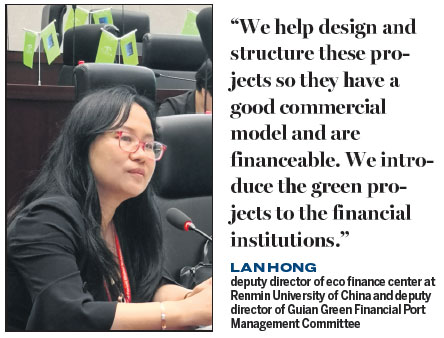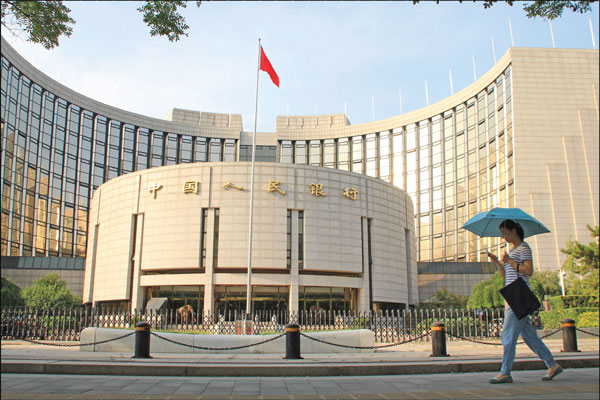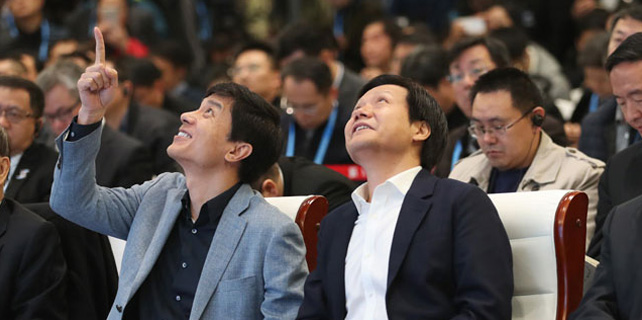Banking on green
China leads world at pushing market financial tools to create an ecological civilization
China's financial regulators are creating incentive programs to encourage banks and other financial institutions to invest the huge sums needed for green development, as part of China's overall goal of building an ecological civilization.
In his speech to the National Ecological and Environmental Protection Conference in May, President Xi Jinping called for a comprehensive approach to promoting green development, including "full use of market means, improving resources and environment pricing mechanisms, and strengthening support for public-private partnership projects."

|
Workers install solar power generation panels in Qinhuangdao, Hebei province. Cao Jianxiong / For China Daily |
|
Han Ruixiang (2nd from right) from ICBC London Branch and Nikhil Rathi (3rd from right) from LSE celebrate the launch of the bank's record-breaking green bond. Angus Mcneice / China Daily |
Deborah Lehr, vice-chairman of the Paulson Institute, a US-based, independent think tank with one of its missions being "to strengthen US-China relations", says: "The government alone can't finance the transition to a low carbon economy, so it needs to find ways to attract private capital to help with this financing. With that motivation, China has played a leadership role in green finance, and is serving as a catalyst for other countries, especially in the developing world.
"However, there is still a long way to go in judging whether China will be successful or not. As the world's largest emitter of carbon, there is a huge challenge ahead not only in developing the right policies for green finance, but ensuring that they are implemented and actively enforced," she says. "But China is definitely moving in the right direction."
Ma Jun, director of the Center for Finance and Development at Tsinghua University and former chief economist of the People's Bank of China, the central bank, told China Daily earlier, "China needs at least 2 trillion yuan ($290 billion; 256 billion euros; £228 billion) of green investment per year over the next five years to promote environmental protection and reduce pollution."
However, only 15 percent of this amount can be paid for by the government, Ji Xiaonan, former chair of the Board of Supervisors for Key Large-Sized State-Owned Enterprises, told Global Times last year.
Worldwide, the green bond market reached $155.5 billion (136.5 billion euros; £122.1 billion) last year, up by 78 percent from $87.2 billion in 2016. Moody's expects the market to reach $250 billion by 2018, according to data from the UK's green finance initiative. This does not include bank loans and other financial instruments.
After regulatory changes in 2015, Chinese issuance of green bonds rose from less than $1 billion in 2015 to leading the world with $23 billion in 2016. US issuance in 2017 was No 1 at $43.3 billion, according to data from the Climate Bonds Initiative using international standards for green bonds. US issuance in 2017 soared because of a single issuance of $24.9 billion of green mortgage-backed securities by Fannie Mae, the US federal government housing lender. Since most Chinese finance is conducted through bank loans, these numbers do not include much of the green finance in China.
As early as 2012, the China Banking and Insurance Regulatory Commission issued Green Credit Guidelines requiring banks "to develop client environmental and social risk assessment criteria, dynamically assess and classify client environmental and social risks, and consider the results as an important basis for credit rating, access, management and exit."
The commission also established key performance indicators to measure banks' performance in creating green loans. As a result, since 2013, green credit has been about 9 percent of total outstanding loans from banks.
The commission also requires banks to "examine the compliance of clients to whom credit is granted". In a first, Ping An bank was fined 500,000 yuan in July for providing financing to environmentally unsatisfactory enterprises.
According to Miao Hong, energy program lead at the World Resources Institute in Beijing, banks have now stopped making new loans to finance the construction of coal-fired power plants.
Huang Biao, unit head of private sector financial institutions at the Asian Development Bank office in Beijing, emphasizes that these policies do not amount to subsidies.
"The core competence of a financial institution is to find good bankable projects that generate good returns with acceptable risk profiles. Introducing a target for green finance gives the loan officer another dimension when he considers the risk/return trade-off," says Huang.
"Choosing projects is not as simple as looking at the first 100. Suppose a loan officer is considering loans to a sustainable energy company and a coal mining company with the same risk/return trade-off. If there is a key performance indicator for green finance, then the loan will go to the renewable energy company," he says.
Cheng Lin, economist and head of foreign affairs at the Center for Finance and Development at Tsinghua University, says green loans are generally at market rates. But some local governments provide incentives based on the greenness of the projects and the enterprise. For example, in Huzhou, Zhejiang province, if a project or enterprise is categorized as "dark green", the interest rates on green loans could be subsidized by 12 percent. The interest rate subsidy for "medium green" is 9 percent, and 6 percent for "light green".
Data from the China Banking and Insurance Regulatory Commission shows that the average default rate on green loans from the 21 major banks in China was only 0.37 percent as of June last year, compared with a default rate of almost 2 percent on all loans.
Cheng argues that companies that pay attention to the environment also pay attention to long-term benefits for themselves and for society.
He recounts the results of stress testing by Industrial and Commercial Bank of China. "ICBC found that, given enhanced environmental regulations and enforcement, major polluting industries such as steel and cement are actually more likely to default."
Cheng adds, "ICBC is the first commercial bank in the world doing formal stress testing based on the environment."
Since 2016, the push toward green finance has intensified. In August that year, the State Council, China's Cabinet, and seven financial and environmental government agencies issued Guidelines for Establishing the Green Financial System. According to the guidelines, "the primary purpose of establishing the green financial system is to mobilize and incentivize more social or private capital to invest in green sectors, while restricting investment in polluting sectors."
Cheng Lin, of Tsinghua, says: "The People's Bank of China, the central bank of China, has included green factors in the macro prudential assessment framework, which is used to encourage commercial banks to make green loans. For example, the commercial banks that have a higher percentage of green loans or which have issued green bonds can be granted extra points in the (macro prudential assessment) system, which will be translated into them receiving higher interest rates on the reserves they have at the PBOC. This encourages commercial banks to extend green loans and at lower cost."
In May, the China Securities Regulatory Commission, the stock regulator, announced that it would increase its focus on green financing and environmental issues. "The CSRC's key target is to reduce financing costs for green companies, and we have abundant means to achieve that goal," CSRC Vice-Chairman Fang Xinghai told Xinhua. The agency will expand pilot zones for green corporate bonds and will focus on environmental issues when reviewing IPOs or new measures, Fang said.
Last year, the National Development and Reform Commission established eight green finance pilot zones in five provinces. In addition, the NDRC is working on the inventory to define and certify green projects. Six domains are included: energy saving and environmental protection projects, clean production, clean energy, ecological and environmental industries, green upgrades in infrastructure, and green services. The categorization of these six domains applies to all their manufacturing, construction and operation phases and related services.
Miao, of the World Resources Institute, says details are under discussion.
The city of Huzhou provides 1 billion yuan per year as an incentive for green finance. For example, it has established an online green finance service platform that connects commercial banks to green enterprises, especially small and medium-sized enterprises.
Cheng, the Tsinghua economist, says this is kind of an online catalog of green projects and green enterprises.
In his 2015 visit to the Guian New District in Guizhou province, another green finance pilot zone, President Xi stressed that the planning and construction of the new district should aim for environmental sustainability, as well as high standards. He urged Guizhou to pursue a new development path that was different from the other provinces, underscoring the need for balancing economic development with environmental protection and ecological conservation, according to Xinhua News Agency.
Lan Hong, deputy director of eco finance center at Renmin University of China and deputy director of Guian Green Financial Port Management Committee, says that the less-developed southwestern provinces of Guizhou, Yunnan and Sichuan have great need for green finance so they can develop in an ecologically sound way. The center serves partly as a matchmaker that links green projects in those provinces with Chinese and international banks.
So far, Guian has attracted 22 banks to its green finance center. The area has also set up a green industrial park that has attracted investment from Tencent and Hyundai data centers and FDG electric vehicles.
Another service, provided for free to users, is help in designing green projects so they can be bankable. "We have a green finance library that has lots of projects we have collected from Guizhou, Yunnan and Sichuan provinces. We help design and structure these projects so they have a good commercial model and are financeable. We introduce the green projects to the financial institutions," says Lan.
Green finance is growing rapidly, but it still has a long way to go. Lehr, of the Paulson Institute, says: "Overall, green bonds have been well received and are often the most cited green finance success story - especially for China. But in the context of the larger global bond market, green bonds are but a drop in the bucket. Globally, the outstanding bond debt is upward of $100 trillion. Estimates for the total number of green bonds issued in 2017 are about $155.5 billion.
"The magnitude of the difference between billions and trillions speaks to how far green bonds have come, but also the progress still needed for green finance."
davidblair@chinadaily.com.cn
|
A pedestrian walks past the People's Bank of China headquarters in Beijing. Shi Yan / For China Daily |
|
People take part in a bike-riding campaign in Huaian, Jiangsu province, to promote green transportation. Zhao Qirui / For China Daily |

(China Daily European Weekly 08/17/2018 page1)






















